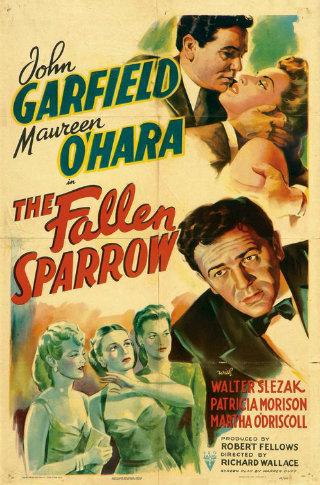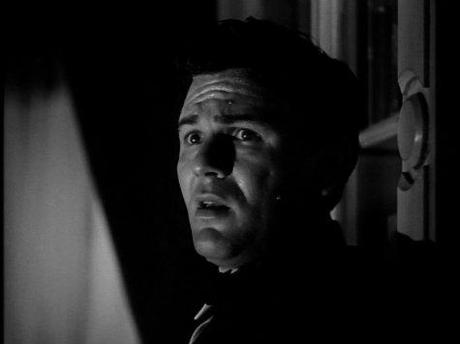
Wartime propaganda movies can be a bit of a mixed bag when viewed with modern eyes, the passage time allowing them to be considered more objectively as pieces of cinema. Some fare very poorly, with weak, stereotypical characterization tending to be the principal fault. On the other hand, there are others which hold up better, which use a little more subtlety and whose stories are more engrossing. The Fallen Sparrow (1943) is one of the stronger efforts, thanks largely to its star and cinematographer. However, it’s not a movie without its faults, most of which stem from an inability to fit comfortably into any one category: it’s a spy thriller with an antifascist message, a film noir in visual terms, and a psychological melodrama. I think it’s the propaganda aspect that lets it down the most though, not because it’s especially dated but more because the motivation of the villains is hard to swallow.
John McKittrick (John Garfield) is a war veteran, not of WWII but the Spanish Civil War. A policeman’s son, he fought on the Loyalist side, was captured and held prisoner long after the conflict had ended. We first see him on a train bound for his native New York. There’s a nervy urgency about the man, and a glimpse at a scrap of newspaper tells us that he’s heading home as a result of an apparently accidental death. A boyhood friend took a dive from a high-rise apartment, and it’s soon made clear that McKittrick is unsatisfied with the official version of events.So far the plot has all the hallmarks of a standard mystery thriller, but it’s McKittrick’s back story that gives it an added twist. During his incarceration in Spain McKittrick was a victim of prolonged sessions of torture, and he only escaped due to the intervention of his recently deceased friend. The effect of this is twofold – McKittrick suspects that the death was no accident and was actually linked to events in Spain; additionally, those years in the dungeons suffering at the hands of faceless tormentors have left him in a psychologically fragile state. With the police keen to give him the brush off, McKittrick sets about looking into the circumstances of the death himself. This leads him into the slightly surreal world of the refugee community – where exiled aristocrats keep company with night club musicians and the granddaughter of a prince (Maureen O’Hara) sells hats to society matrons for a living. Within this odd milieu lurks the threat of a fascist cell and its preoccupation with the recovery of one of the more unusual spoils of war. Teetering on the brink of sanity, McKittrick weaves his way through this group of blue bloods, spies and assorted lackeys in an effort to get to the bottom of the mystery and exorcise his personal demons.

Richard Wallace isn’t a director i can say I’m all that familiar with. He’s probably best know for taking charge of Sinbad, the Sailor with Douglas Fairbanks Jr, but he also made a moderately good noir, Framed, with Glenn Ford. Both Framed and The Fallen Sparrow show that Wallace had some talent for the dark cinema, and this movie in particular features a few very nice touches. I guess the fact that Nicholas Musuraca, who photographed some of the most visually interesting film noirs, was behind the camera helped a lot, and the pair conjure up a handful of scenes whose atmosphere wouldn’t look out of place in a horror movie. There are plenty of impenetrable shadows that whisper menace, and architectural features like pillars and balustrades are used to pin the hapless and haunted McKittrick in place. The overall effect is to heighten the sense that the hero of the movie is still trapped by the ghosts and monsters of his past, and he frequently seems to be as much the prey of the dark forces crowding around him as the hunter he’s trying to be.
The film very much belongs to John Garfield, although there’s good support from Maureen O’Hara and Walter Slezak. I think Garfield is one of the most tragic figures of Hollywood’s Golden Age – a man of immense talent and raw power doomed by poor health and the political climate of the times. He always came across to me as the tough guy with the soft center, possessed of a streetwise cockiness and vulnerability that, while an elusive quality, was a key ingredient of the finest noir protagonists. His career lasted only thirteen years and by 1952 he was dead, aged just 39. He suffered from a heart condition and it’s highly likely that his hounding by HUAC during the McCarthyite Red Scare of the late 40s and 50s was a contributory factor in his early demise. However, in the short time he graced the screen with his presence, Garfield made some terrific and memorable movies, especially noir pictures. Body and Soul, Force of Evil and The Breaking Point are all genuine classics as far as I’m concerned, and even his lesser works like The Fallen Sparrow show how good he could be. I think the most interesting thing about this movie isn’t really the plot, instead it’s Garfield’s portrayal of a severely damaged individual, a psychologically shattered man clinging to the remnants of his sanity. His terror, as the nights draw in and the shadows lengthen, is palpable. The viewer really gets to share in his dread, boxed up in his apartment and sweating despite the snow falling outside, as the dragging footsteps of the limping man of his nightmare past echoes in his mind. Walter Slezak brought a creeping menace to many roles, not least Hitchcock’s Lifeboat, and his turn as a crippled intellectual fascinated by man’s cruelty to man is well realized. The early scene where he softly lectures a drawing-room of stuffy society types on the delicacies of the torturer’s art, as Garfield stands awkward and withdrawn before him, is a chilling moment. Maureen O’Hara is only one of three women linked to the mystery – the others being Patricia Morison and Martha O’Driscoll – but she gets the meatier and more significant role. She’s not an actress that you would automatically associate with film noir but does fine as a possibly duplicitous woman with divided loyalties.

The Fallen Sparrow was an RKO production and is now widely available in DVD in Spain, Italy, France and the US (via the Warner Archive). I have the UK edition of the film released by Odeon and it’s a reasonable transfer. The image is fairly sharp and has good contrast levels to show off Musuraca’s photography. However, it has to be said the print is quite dirty, with plenty of speckles and instances of minor damage. The disc is completely free of extras, just the option to play the movie or select a scene. The movie is adapted from a book by Dorothy B Hughes and while it’s not up to the standards of the best versions of her stories – In a Lonely Place and Ride the Pink Horse – I reckon it’s still a movie that most fans of film noir would want to see. I feel that aspects of the plot, derived from the overdone combination of propaganda, espionage and melodrama, do hurt it. Having said that, Garfield’s intense performance and Musuraca’s beautiful, atmospheric photography raise the quality quite a few notches. All in all, it’s an enjoyable if not wholly successful film.
